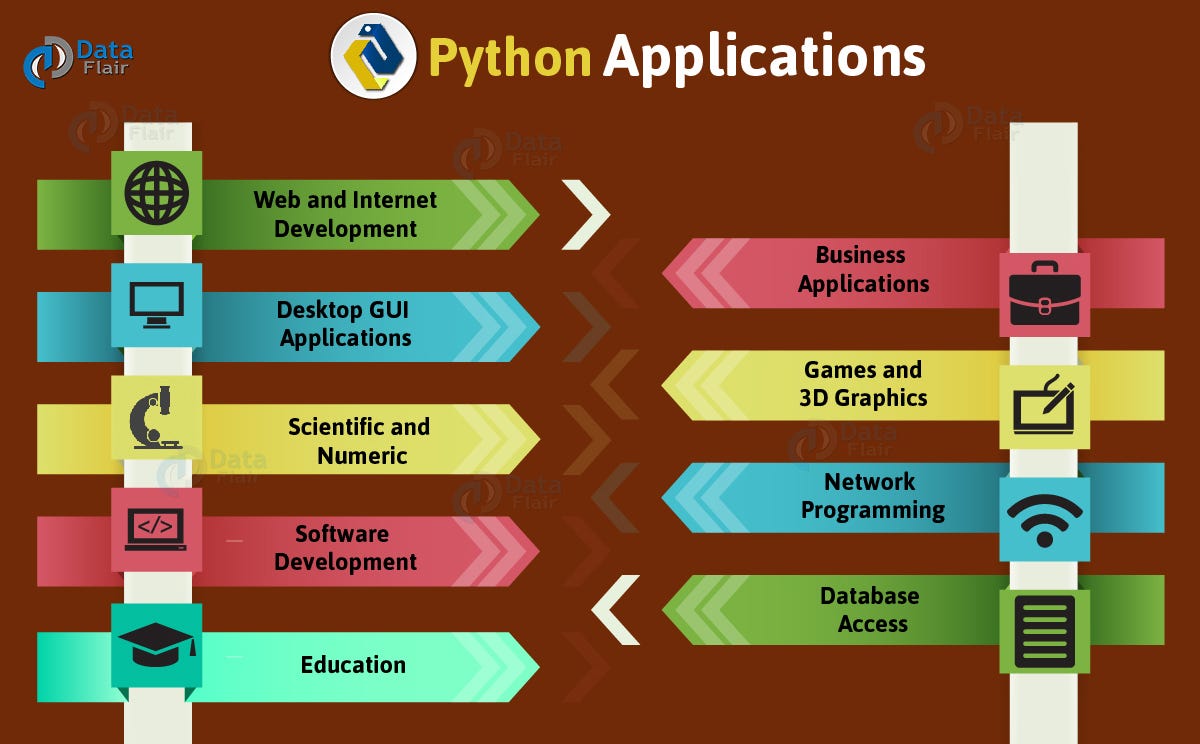How Python is used in real time?
How Python is used in real time?
Python is widely used in various industries and domains to solve complex problems efficiently. Here are some examples of how Python is used in real-time:
Data Science and Machine Learning: Python's simplicity, flexibility, and extensive libraries (e.g., NumPy, Pandas, scikit-learn) make it an ideal choice for data scientists and machine learning engineers. They use Python to analyze and visualize data, train models, and build predictive algorithms.For instance, the popular open-source library TensorFlow is built using Python. It's used to develop deep-learning models, which are employed in applications like image recognition, natural language processing, and autonomous vehicles.
Web Development: Python's Flask and Django frameworks make it an excellent choice for building web applications quickly and efficiently. Many websites and web services rely on Python-based backends, including Instagram, Pinterest, and Netflix.Python is also used in web scraping, crawling, and data extraction tasks due to its simplicity and ease of handling HTML and XML parsing.
Automation and Scripting: Python's straightforward syntax and extensive libraries (e.g., requests, BeautifulSoup) make it a popular choice for automating repetitive tasks, such as: Web automation: Scraping data from websites or automating web-based tasks. System administration: Automating system maintenance, backups, and monitoring. Data processing: Processing large datasets, converting formats, and performing calculations.For example, Python scripts can be used to automate tasks like data entry, sending emails, or generating reports.
Scientific Computing: Python's NumPy and SciPy libraries provide a powerful environment for scientific computing, including: Numerical simulations Data analysis Machine learningResearchers use Python to analyze complex scientific data, simulate phenomena, and visualize results. Examples include climate modeling, particle physics simulations, and bioinformatics research.
Education: Python's simplicity and ease of use make it a popular teaching language in computer science courses. It's often used as a first programming language due to its: Forgiving syntax High-level abstractions Extensive librariesStudents can quickly learn Python basics, which enables them to focus on more complex concepts and projects.
Research and Academia: Python's versatility and extensibility make it an ideal choice for various research fields, including: Computational biology: Analyzing genomic data and simulating biological processes. Computer vision: Developing algorithms for image recognition and object detection. Natural language processing: Building chatbots, sentiment analysis tools, and language translation systems.Academics use Python to analyze complex data, develop new algorithms, and visualize results. It's an essential tool in many research domains.
Gaming: Python is used in game development for various tasks, including: Game logic programming Graphics rendering Physics simulationsPython-based frameworks like Pygame and Panda3D enable developers to create games with ease, focusing on gameplay mechanics rather than low-level graphics details.
Business Intelligence: Python's data analysis capabilities make it an excellent choice for business intelligence tasks, including: Data visualization Reporting Predictive analyticsCompanies use Python-based tools (e.g., pandas, statsmodels) to analyze and visualize business data, making informed decisions and optimizing processes.
These examples demonstrate the wide range of applications where Python excels. Its simplicity, flexibility, and extensive libraries make it an ideal choice for various industries and domains.
Everyday uses of Python

I'm happy to respond in English for you!
Python is an incredibly versatile language that has many everyday uses beyond just programming and coding. Here are some examples:
Data Analysis: Many professionals use Python for data analysis, such as scientists, researchers, and analysts. They can leverage libraries like Pandas, NumPy, and Matplotlib to quickly clean, manipulate, and visualize large datasets. Automation: Automating repetitive tasks is a great way to save time and increase productivity. For instance, you can use Python to automate file organization, renaming files, or sending emails. The possibilities are endless! Web Scraping: Web scraping involves extracting data from websites without violating their terms of service. Python's BeautifulSoup and Scrapy libraries make it easy to extract specific information from web pages. Machine Learning: With popular libraries like TensorFlow, Keras, and Scikit-Learn, you can train and deploy machine learning models using Python. This has many practical applications in areas like computer vision, natural language processing, and predictive maintenance. Scripting: Python is an excellent scripting language for automating tasks on your computer or network. You can write scripts to perform tasks like renaming files, sending emails, or updating databases. Education: Python is often taught in schools as a beginner-friendly programming language. Its simplicity and versatility make it an ideal teaching tool. Scientific Computing: Many scientists use Python for scientific computing due to its ease of integration with popular libraries like NumPy, SciPy, and Matplotlib. This enables them to analyze complex data sets and create visualizations. Network Security: Network security professionals can use Python's socket library to build custom network protocols or automate tasks like network scanning and penetration testing. Gaming: The Pygame library allows developers to create 2D games using Python. You can also integrate Python with other game engines for more complex projects. Automation Testing: Testers can leverage Python's unit testing framework (unittest) and libraries like Selenium to automate web-based tests, ensuring software meets required standards before release. Image Processing: With libraries like OpenCV, you can perform image processing tasks like object detection, facial recognition, or image filtering using Python. Virtual Assistants: AI-powered virtual assistants often rely on Python for their natural language processing and machine learning capabilities.These are just a few examples of how Python is used in everyday life beyond programming and coding. Its versatility and ease of use make it an excellent choice for many tasks!





























